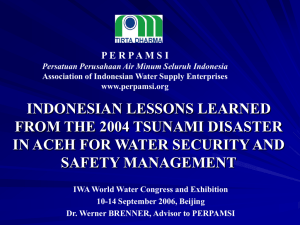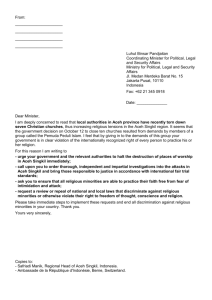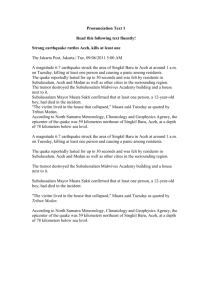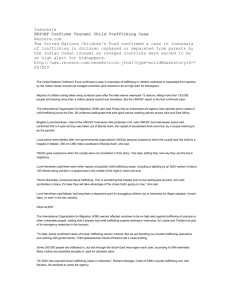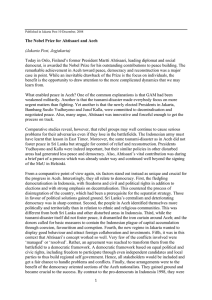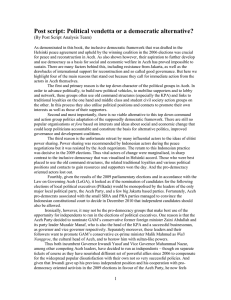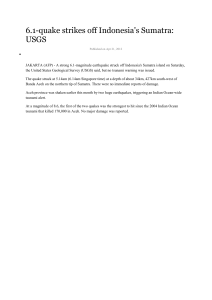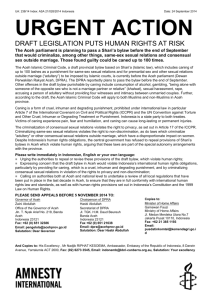DFAT Formal Factsheet
advertisement
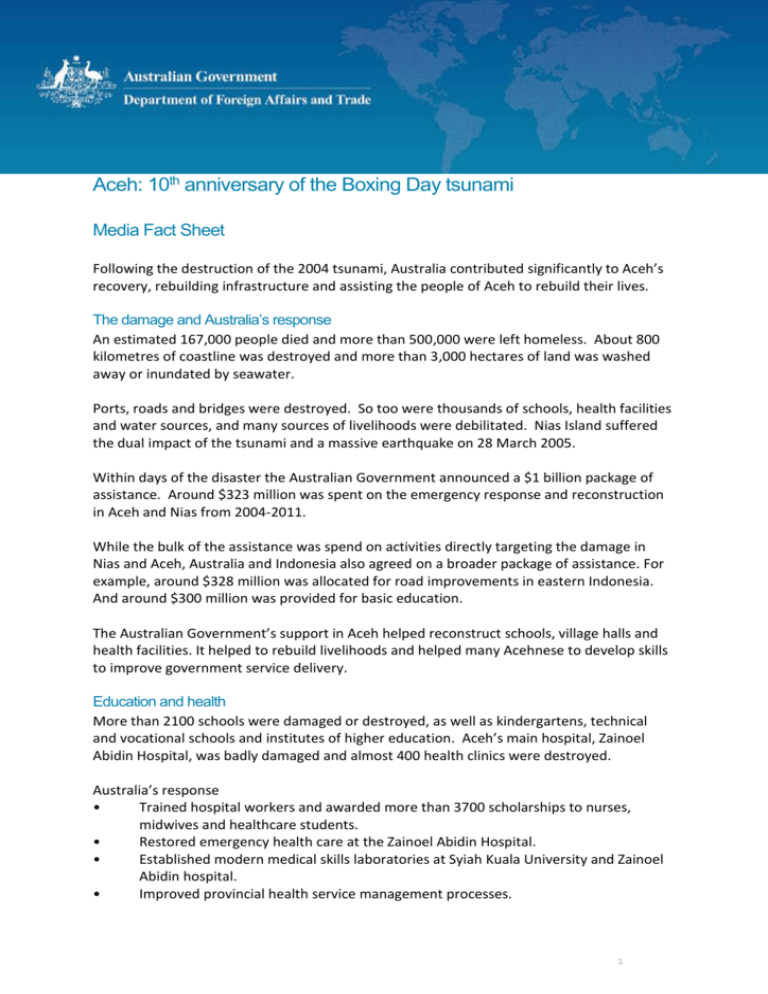
Aceh: 10th anniversary of the Boxing Day tsunami Media Fact Sheet Following the destruction of the 2004 tsunami, Australia contributed significantly to Aceh’s recovery, rebuilding infrastructure and assisting the people of Aceh to rebuild their lives. The damage and Australia’s response An estimated 167,000 people died and more than 500,000 were left homeless. About 800 kilometres of coastline was destroyed and more than 3,000 hectares of land was washed away or inundated by seawater. Ports, roads and bridges were destroyed. So too were thousands of schools, health facilities and water sources, and many sources of livelihoods were debilitated. Nias Island suffered the dual impact of the tsunami and a massive earthquake on 28 March 2005. Within days of the disaster the Australian Government announced a $1 billion package of assistance. Around $323 million was spent on the emergency response and reconstruction in Aceh and Nias from 2004-2011. While the bulk of the assistance was spend on activities directly targeting the damage in Nias and Aceh, Australia and Indonesia also agreed on a broader package of assistance. For example, around $328 million was allocated for road improvements in eastern Indonesia. And around $300 million was provided for basic education. The Australian Government’s support in Aceh helped reconstruct schools, village halls and health facilities. It helped to rebuild livelihoods and helped many Acehnese to develop skills to improve government service delivery. Education and health More than 2100 schools were damaged or destroyed, as well as kindergartens, technical and vocational schools and institutes of higher education. Aceh’s main hospital, Zainoel Abidin Hospital, was badly damaged and almost 400 health clinics were destroyed. Australia’s response • Trained hospital workers and awarded more than 3700 scholarships to nurses, midwives and healthcare students. • Restored emergency health care at the Zainoel Abidin Hospital. • Established modern medical skills laboratories at Syiah Kuala University and Zainoel Abidin hospital. • Improved provincial health service management processes. 1 Media Factsheet • • Supported teacher training in areas hit hard by the tsunami Provided support to the reconstruction and improved management of schools in areas affected by civil conflict. Livelihoods The tsunami devastated sources of livelihoods for many of Aceh’s coastal people. Australia played a role helping many of those affected to get back to work. Australia’s response • Rebuilt Aceh’s main hatchery which supplies the ponds of local fish farmers. • Provided training on better aquaculture management practices. • Trained small business clients throughout Aceh and Nias in business planning, marketing and financial management. • Formed village micro-credit groups to develop livelihoods and small self-help initiatives such as fish and prawn farms, tailoring, motorcycle taxis and restaurants. • Trained agricultural workers and farmers to restore soil fertility. Infrastructure and housing About 85 per cent of all infrastructure in Banda Aceh was damaged by the tsunami. Damage to more than 3000 kilometres of roads, bridges and ports cut off access to many parts of Aceh’s coast, while inNias, the combined impact of the tsunami and the earthquake left infrastructure badly in need of repair. Australia’s response • Provided digital maps to help the government and NGOs with the reconstruction. • Provided Acehnese construction workers, builders, plumbers and electricians with training in housing construction. • Supported community involvement in building houses and educated communities to monitor the quality of housing construction. • Gave communities better access to water and sanitation facilities, roads and bridges, schools, government services, emergency services and markets. • Provided survey and mapping data for managing and maintaining more than 20, 000 schools, hospitals and other public assets that have been built in Aceh since the 2004 tsunami. 2 Media Factsheet Ulee Lheue Port Reconstruction Project Ulee Lheue Port was destroyed by the tsunami. Prior to the disaster the Port was a major transport hub providing a large cargo ferry service and passenger ferry services for up to 600 passengers per day, including small traders and families. Australia’s response • Helped to restore the port within one year, re-opening in December 2005. • This allowed for vital reconstruction materials to be moved in and out of Banda Aceh. Governance The tsunami and 30 years of civil conflict severely diminished the capacity of the Aceh Government to respond to people’s needs and deliver services. Equipment and public records were washed away, government buildings destroyed and service delivery completely disabled. Australia’s response • • Delivered training to local government officers on leadership, IT skills, planning and budgeting. Helped establish "one-stop-shops" to deliver services more quickly and cheaply. Trained community leaders, more than half of whom were women, in 204 villages. 3

